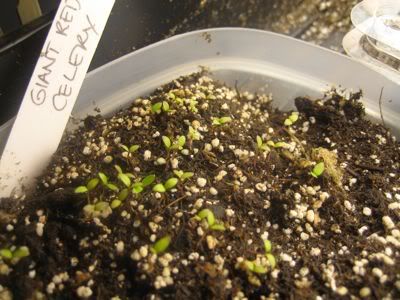Apium graveolens var dulce: First grown as an herb and as a flavoring, celery is now eaten in 3 main forms: celery leaf, sometimes called soup celery; the swollen leaf petiol which is the familiar celery stick form; and the swollen rootstock we know as celeriac Apium graveolens var. rapaceum. Celery is 94% water, which makes it a great diet food. Some dieters claim that chewing celery uses more calories than the stalks contain.
CULTURE: The most successful crops are grown for fall harvest rather than mid-summer harvest. Weather fluctuations and cold nights cause celery to bolt. Sow 1/8 inch deep in sterile seedling mix indoors February through April. Keep soil moist. Days to emergence: 10-20. When raising transplants, you must keep soil temperatures above 55°F and below 70°F. This is vital to success. Transplant 12 inches apart in rows at least 18 inches apart when the weather is warm enough for peppers and melons. Celery is one of the heaviest feeding plants grown in the garden. Apply 1 1/2-2 cups of our complete fertilizer into the soil per 5 row feet to provide adequate nutrition. Also keep well watered; the small-diameter roots grow deeply, adapted to draw large amounts of water from wet, boggy places. Bolting is the result of young plants being exposed to nighttime air temperatures below 55°F for a week or more. Direct sowing is not recommended.
DISEASE: Good preventive measures include crop rotation, adequate water supply, and aphid control.
INSECTS/PESTS: The larva of the carrot fly is an occasional celery pest. Mature larva are 3/8 inch long, straw-colored, and wiry. Worms burrow into the heart and kill or stunt the plant. Crop row covers such as Reemay, Grow Guard 20, or Summer Insect Barrier are very effective deterrents.
HARVEST: In mild climates, celery and celeriac can be overwintered in the ground. Chopping off the entire head is not advisable. Instead, pick individual stalks as needed. In spring, the unopened flowers and the tender stalks below them are particularly good tasting. Where winters are severe, the plants must be dug and stored in a root cellar.
SEED SPECS: Minimum germination standard: 65%. Days to maturity calculated from date of transplant; add 60 days if direct seeding. Usual seed life: 3 years. Approximately 1000 seeds per 1/2 gram; 1/4 ounce is 7 grams.
----------
WHEN TO PLANT: Celery maybe planted indoors in February or March and set out about two weeks after the last expected frost or sown in April or May for a fall crop. Germination is fairly slow - about three weeks. Celery does best in cool weather, so the fall crop is often the best. Celery germinates best at 60°F to 70°F.
HOW TO PLANT: If temperature at planting time is unfavorably high, exposure to light will help to stimulate germination. Alternating temperatures (warmer by day, cooler by night) also helps. At the preferred lower temperature, light doesn't seem to make any difference. Keep the soil evenly moist during germination. When hardening off, avoid chilling the plant below 50°F or it may bolt to seed. Celery has a skimpy root system and transplants well as long as the job is done early, when the seedlings are 3-5" high, before a tap root forms.
GROWING CONDITIONS: Because celery's ancestors were marsh dwellers, it needs a steady and plentiful supply of moisture, more then most other garden vegetables but drainage should be good. Try sinking bottomless cans between plants, which should be planted 8-10" apart and filling the cans with water from the hose. Celery is a heavy feeder too, so put compost in the planting hole and give plants extra feeding of manure tea or fish emulsion about twice a month.
----------
PURCHASED: 1/2g from Territorial Seed Co. Jan '09. $2.15
STARTED SEED: With our weather I'm not sure if this crop will do best as a spring or fall so I'll try a little of both. Started my spring seeds on 02/23/09. Sprouted on 03/03/09 - 8 days to germinate.
HARDENED OFF:
TRANSPLANTED IN GARDEN:
DISEASE ISSUES:
INSECT ISSUES:
HARVEST YEILD & DURATION:
OTHER NOTES:
03/16/09

03/23/09

1 comment:
Thanks for this info. Just trying Giant Red Celery this year so your info was great to read.
Post a Comment